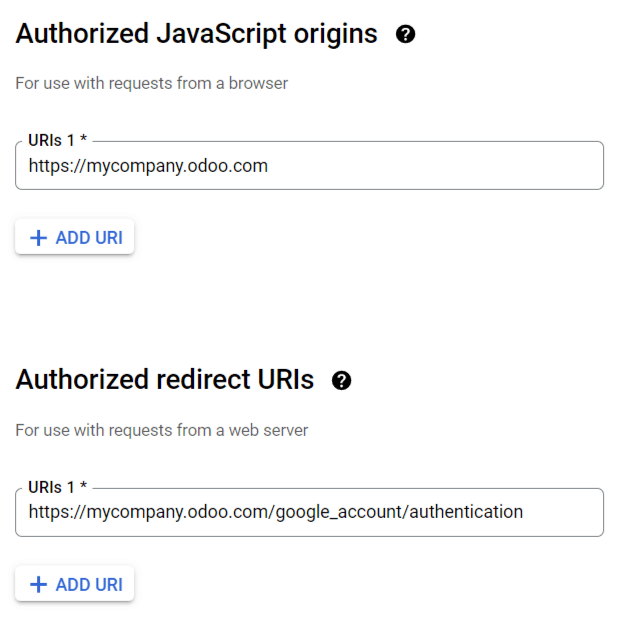Synchronize Google calendar with SotaERP¶
Synchronize Google Calendar with SotaERP to see and manage meetings from both platforms (updates go in both directions). This integration helps organize schedules, so a meeting is never missed.
See also
/administration/maintain/google_oauth
Setup in Google¶
Select (or create) a project¶
Create a new Google API project and enable the Google Calendar API. First, go to the Google API Console and log into the Google account.
Note
If this is the first time visiting this page, Google will prompt the user to enter a country and agree to the Terms of Service. Select a country from the drop-down list and agree to the ToS.
Next, click Select a project and select (or create) an API project to configure OAuth in, and store credentials. Click New Project.

Tip
Give the API Project a clear name, like “SotaERP Sync”, so it can be easily identified.
Enable Google calendar API¶
Now, click on Enabled APIs and Services in the left menu. Select Enabled APIs and Services again if the Search bar doesn’t appear.

After that, search for Google Calendar API using the search bar and select Google
Calendar API from the search results. Click Enable.

OAuth consent screen¶
Now that the API project has been created, OAuth should be configured. To do that, click on OAuth consent in the left menu and then select the User Type.
Warning
Personal Gmail Accounts are only allowed to be External User Type, which means Google may require an approval, or for Scopes to be added on. However, using a Google WorkSpace account allows for Internal User Type to be used.
Note, as well, that while the API connection is in the External testing mode, then no approval is necessary from Google. User limits in this testing mode is set to 100 users.
In the second step, OAuth Consent Screen, type SotaERP in the App name field,
select the email address for the User support email field, and type the email address
for the Developer contact information section. Then, click Save and
Continue.
Skip the third step, , by clicking Save and Continue.
Next, if continuing in testing mode (External), add the email addresses being configured under the Test users step, by clicking on Add Users, and then the Save and Continue button. A summary of the app registration appears.
Finally, scroll to the bottom, and click on Back to Dashboard.
Now, the OAuth consent has been configured, and it’s time to create credentials.
Create credentials¶
The Client ID and the Client Secret are both needed to connect Google Calendar to SotaERP. This is the last step in the Google console. Begin by clicking Credentials in the left menu. Then, click Create Credentials, and select OAuth client ID, Google will open a guide to create credentials.
Under , select Website application for the
Application Type field, and type My SotaERP Database for the Name.
Under the Authorized JavaScript Origins section, click + Add URI and type the company’s SotaERP full URL address.
Under the Authorized redirect URIs section, click + Add URI and type the company’s SotaERP URL address followed by
/google_account/authentication. Finally, click Create.

A Client ID and Client Secret will appear, copy these to a notepad.
Setup in SotaERP¶
Once the Client ID and the Client Secret are located, open the SotaERP database and go to . Check the box next to Google Calendar.

Next, copy and paste the Client ID and the Client Secret from the Google Calendar API credentials page into their respective fields below the Google Calendar checkbox. Then, click Save.
Sync calendar in SotaERP¶
Finally, open the app in SotaERP and click on the Google sync button to sync Google Calendar with SotaERP.

Note
When syncing Google Calendar with SotaERP for the first time, the page will redirect to the Google Account. From there, select the Email Account that should have access, then select Continue (should the app be unverifed), and finally select Continue (to give permission for the transfer of data)`.

Now, SotaERP Calendar is successfully synced with Google Calendar!
Warning
SotaERP highly recommends testing the Google calendar synchronization on a test database and a test email address (that is not used for any other purpose) before attempting to sync the desired Google Calendar with the user’s production database.
Once a user synchronizes their Google calendar with the SotaERP calendar:
Creating an event in SotaERP causes Google to send an invitation to all event attendees.
Deleting an event in SotaERP causes Google to send a cancellation to all event attendees.
Adding a contact to an event causes Google to send an invitation to all event attendees.
Removing a contact from an event causes Google to send a cancellation to all event attendees.
Events can be created in Google Calendar without sending a notification by selecting Don’t Send when prompted to send invitation emails.